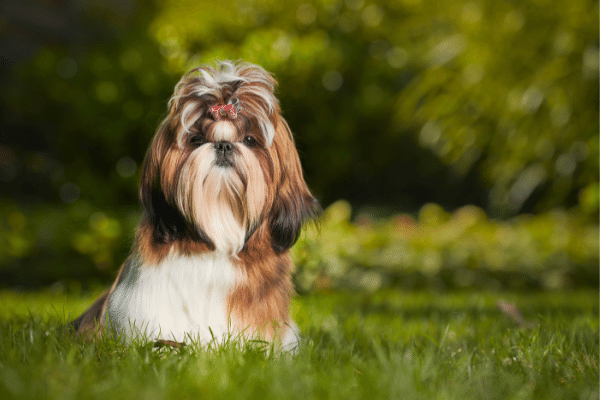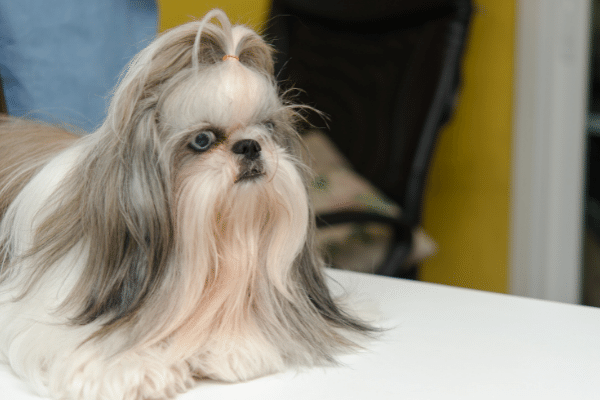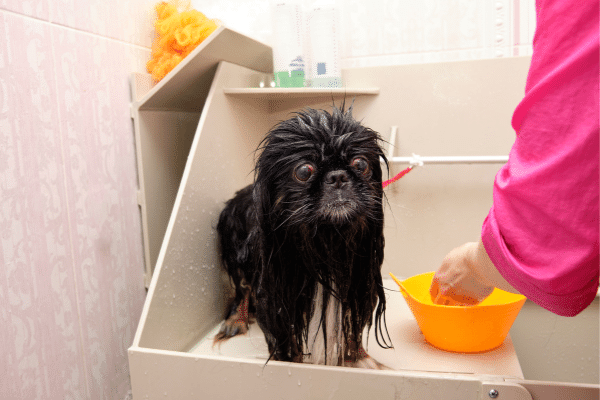The Shih Tzu is the ideal pet for your family because it is calm, playful, loyal, and friendly. However, they are prone to skin disorders, whether it is a food allergy, an environmental allergy, or a skin allergy caused by their short nose and double coat.
We know it is so devastating to see your pet in pain. And because we understand this, we’ve gathered all the available information about Shih Tzu skin disorders. We have also shared some home remedies and cures.
You can read and comprehend information in detail.
Shih Tzu Coat and Fur

Shih Tzu has two layers in its fur. They have dense, long flowing coats. When you run your hands over their coat, you’ll notice that the top layer is tough, but the inner is soft.
In the case of skin allergies, it becomes quite challenging to determine which coat is affected since both parts appear flaky.
So, to grasp things better, let’s look at the different types of skin problems that a Shih Tzu can have.
Shih Tzu skin problems

Dermatitis
The most common skin problem found in Shih Tzu is Dermatitis. This is a skin condition under which skin turns into red patches.
These patches are extremely uncomfortable because they induce itching and, in some cases, pus.
You must show your Shih Tzu to the vet if you see red patches on his skin. He may prescribe antibiotics or antifungal medicines.
If it is not major, you can treat this problem at home too. You get antifungal shampoo and clean his body thoroughly with cold water.
Generally, it will work after a few washes. But, I will still advise you to seek professional help as it is a matter of skin problem.
There are also different kinds of Dermatitis that a Shih Tzu can carry. Let’s check the next section for that.
Nasal fold and tail fold dermatitis
As the name itself describes, this skin disorder develops under the tail. The moisture and dirt under the Shih Tzu tail are trapped, which leads to this skin infection.
The bacteria inside the area keep on multiplying and create an infection in the folds.
If your Shih Tzu is affected by this skin problem, you will see redness, odor, and discharge coming out of the infected tail area.
This skin disorder can also happen to obese dogs, dogs with wrinkles like bulldogs, and lastly to dogs with short noses. Shih Tzu falls under the “short-nosed” category because they have a short snout.
Acute moist Dermatitis
As Shih Tzu have long coats, they are also prone to Acute moist Dermatitis. This is likely to occur in summers.
You must be wondering what exactly Acute moist dermatitis is? Well, these are localized patches of skin irritation and bacterial infection and are also referred to as hot spots.
In the initial phase, it may look like an insect bite, and when the treatment is not provided, it can spread all over into red, oozing lesions.
Generally, it is triggered because Shih Tzu may start scratching, licking, or chewing the affected area.
However, it is likely to occur because of the following.
- Parasites
- Flea allergy dermatitis
- Food allergies
- Atopic Dermatitis
- Ear or skin infections
- Anal sac disease
- Contact irritants
- Stress or boredom resulting in excessive licking
- A dirty or matted coat
- Moisture stored in the coat after bathing your Shih Tzu
And the symptoms of hot spots are
- Redness
- Swelling
- Hair loss
Skin problem due to skin allergy
Food allergy is rare in Shih Tzu breeds. Dietary intolerance can occur due to wheat, corn, soy, eggs, colorants, preservatives, eggs, and specific proteins.
A food allergy happens because Shih Tzu’s immune system is not ready to fight it off. Their immune system misidentifies food as dangerous and launches an attack. As a result, there is a reaction.
If your Shih Tzu is suffering, his body will begin to itch. It can affect the head, paws, neck, ear, tail, and stomach.
Identifying which food causes allergy is not less than a task for you. Your Shih Tzu may experience symptoms like diarrhea, vomiting, coughing, sneezing, swelling, and inflammation in adverse cases.
Environmental related skin problems
Skin problems in Shih Tzu are not just related to food. It can also happen because of the surrounding, pollution, pollen, dirt, etc.
If you saw your Shih Tzy scratching his face, feet, stomach, or chest all of a sudden, that means something is wrong. He must have come in contact with irritants from the environment.
This kind of allergy is categorized as “atopy,” just like when we have hay fever. It is similar to that. However, instead of watery eyes and sneezing, dogs get itchy skin.
Some common allergens for dogs in the environment that cause skin allergies are
- Grass
- Dust mites
- Pollen
- Weeds
Skin problems due to fleas and ticks
If your Shih Tzu fur is infested with ticks and fleas, then he is likely to face skin problems. It is because ticks and fleas bite them and suck all the blood. The saliva of fleas spreads over the body, which later irritates. As a result, he itches profusely.
If he scratched the bite marks more than usual or chewed his fur more than usual, it indicates fleas and ticks are present. Your pet’s hair may fall out in huge sections in severe conditions.
Ringworms
Shih Tzus can develop skin problems from a fungus called ringworm.
The ringworms come in a circular shape, and they can occur anywhere on their body. However, it generally grows and lives on their head, paws, ears, and forelegs.
It is generally transmitted to dogs via direct contact with the fungus. When your pet comes into close contact with an infected animal or person or touches a contaminated material such as a couch, food bowls, bed, or carpet, this can happen.
You can take your Shih Tzu to the vet if you see the following symptoms:
- Circular areas of hair loss
- Dry, brittle hair
- Scabby, inflamed skin
- Rough, brittle claws
Mange
Shih Tzu can also face skin problems due to Manges. Magnes is a skin disorder caused by mites.
Generally, there are 2 kinds of it: one happens because of Demodex mite “demodectic mange.” It is likely to happen when canines are not more than 1 year old.
Another is the Sarcoptic mange caused by Sarcoptes mites. Under this condition, the dog will immensely itch his ears.
If you notice the following sign in your Shih Tzu, then you must take him for management treatment.
- Hair loss on face and legs
- Itchiness
- Redness
Now that you know everything about skin problems, do you know how to cure them? Check that in the coming section.
How to treat skin issues?

Now, let’s learn how to help your pet with skin problems.
Treatment for environmental allergens
In case if skin issue is likely to occur due to environmental allergens, you can get Shih Tzu tested.
However, there is no cure for this. Still, there are some common treatment options for this issue:
- Avoiding exposure to the allergen.
- Managing the signs and symptoms (itching, dry skin, etc.)
- Immunotherapy solutions like allergy shots.
- To address canine allergies, doctors usually utilize a mix of this treatment approach.
Eliminating diet
To detect food allergies in Shih Tzu, you can try the elimination diet method. You have to use one protein and carbohydrate source for at least 8 weeks in this method. This is the best strategy to find a food allergen.
In this method, your Shih Tzu won’t be allowed to eat any other food source.
Note: Keep an eye on and make sure your pet doesn’t eat any scrap from the floor.
Later, additional food items can be gradually reintroduced after the elimination diet, with careful monitoring for adverse responses.
Treatment for ringworms
The vet will diagnose ringworms through diagnostic tests and physical examinations. He will take the sample from pet skin or examine infected hair under a UV light called a wood’s lamp.
After this, he will plan treatment according to the severity of the case. Generally, it will include
Mange, flea, and ticks treatment for Shih Tzu
Your vet will look for the dog’s skin sample under the microscope and detect whether there are mites, fleas, or ticks or not. After that, he will prescribe tablets medicated shampoos to ease the itchiness and kill creatures.
You can prevent Shih Tzu’s skin infection and treat his wounds at home as well. Want to know how? Then get ready to read the coming section.
Home remedies for Shih Tzu skin problems!

Clean infected area with wipes
In the case of Nasal fold and tail fold dermatitis, you can always ensure to properly clean Shih Tzu’s tail and skin folds as much as possible. You can also use antifungal wipes to clean the areas.
Note: Always use a clean and damp cloth. For better results, you can try antibacterial solutions like chlorhexidine or betadine.
Trim Shih Tzu fur
Next, you can trim hair near the infected area of the hot spots. This will help air circulation and keep the area dry.
Note: Groom your dog on a regular basis to prevent dirt and debris from accumulating.
Cone of shame and anti-flea collars for Shih Tzu
To prevent excess licking, you can try the cone of shame, also known as the Elizabethan collar.
For fleas and ticks, you can purchase anti-flea collars from the store. It can save your pet from itchy, annoying flea bites.
Maintain humidity
You should maintain adequate humidity levels in the house throughout the winter and apply allergen-blocking strategies all year.
Leave-in conditioner
Next, try a coat that stays on after you wash it off. A leave-in conditioner not only improves the quality of the coat but also protects the skin. This is especially true for Shih Tzu.
Essential oils for healthy skin
Essential oils can also work well to prevent fleas. You can try coconut oil. Either give your pet orally (in small quantities) or apply it to his coat. (The more lauric acid in the oil, the more effective it will be).
Note: Make sure to use diluted essential oil as it can be harmful to his skin.
You can also try a few drops of neem oil with dog shampoo and thoroughly bathe your dog. It will prevent fleas.
Epsom salt for wounds
Next, you can try Epsom salts, which are high in magnesium (can be used to soothe painful muscles). This can be used to soak and clean wounds as it has anti-inflammatory qualities.
You can combine the Epsom salts with warm water and clean your pet for five to ten minutes. You can try doing this thrice a day for better results.
Oatmeal bath
Give your Shih Tzu an oatmeal bath. Oatmeal has anti-inflammatory properties that can help to soothe skin irritation.
You just have to grind some oatmeal into a fine powder and mix it with water. Then apply on the infected area or simply add the oatmeal powder with warm water and let him soak the solution for 5 to 10 minutes.
Chamomile tea for Shih Tzu
You can use chamomile tea for red skin bumps and rashes. Yes, you read it right. You can use chamomile tea for your dog.
You don’t need to do a lot of hustle. Just make the tea and cool it before putting it in a spray bottle. Then spray it over the inflamed region. It will decrease the levels of redness.
Although this is an effective measure, I would advise you to speak to your vet before applying this solution.
Licorice Root for Itchiness
Even after a flea’s bathe, your Shih Tzu still faces itchiness, so you can try Licorice roots.
Licorice items for dogs are also available at pet supply stores. Licorice root may be included in some dog-specific medications developed to relieve allergy issues.
To use this, you have to take five drops each of licorice root, dandelion root, and cat’s claw. Mix the three ingredients together and give your dog five drops of the final solution once a day for 14 days.
Note: Because cortisone is a steroid, it’s crucial to consult your veterinarian before administering these medications to your dog to avoid any potential drug interactions or negative effects.
Omega 3 for good skin
You can try an omega 3 fish oil supplement to keep your Shih Tzu skin and coat healthy. Moreover, it also builds his immune system stronger and helps to make his joints better.
Well, that’s a wrap!
Skin problems in Shih Tzu can vary, and at some point in life, the majority of them will have skin problems.
If they start snatching, licking, or tugging their hair all of a sudden, it could be an indication of a skin illness. You should seek professional assistance. In such instances, a delay can result in significant adversity.
Although there are many home solutions for rashes, wounds, and swelling, I recommend consulting your veterinarian first as your veterinarian will examine you thoroughly and recommend medications to treat the problems at their root.
If you know of any other preventive measures to heal skin issues of the Shih Tzu dog, please tell us in the comments.
.
.

Dr. Aram Baker has been with Santa Clarita Animal Hospital since 1995 and his special interests include behaviour medicine and dermatology. He graduated from the Cleveland Humanities Magnet Program in Reseda, CA and attended California State University at Northridge where he received a Bachelor’s degree in biology. He went on to pursue his Doctorate in Veterinary Medicine at the University of California at Davis. He also spent time in the zoological medicine department at U.C. Davis during his Junior and Senior years. He is dedicated to caring for all pets big or small, young or old with compassion, patience, kindness, and love.
